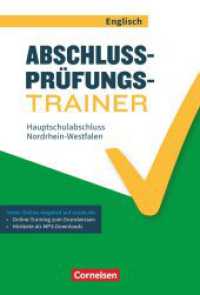- ホーム
- > 洋書
- > ドイツ書
- > Mathematics, Sciences & Technology
- > Technology
Description
(Text)
Seminar paper from the year 2017 in the subject Engineering - General, Basics, grade: 1.5, University of Eastern Philippines, course: Civil Engineering, language: English, abstract: To prevent internal erosion and particle migration, control of seepage pressures and velocities must be given due consideration in the design of hydraulic structures. The percolation length (seepage) for a foundation can be determined by using various methods. There are number of methods available to analyze the problem on seepage and uplift pressure, and one of which is Bligh's theory of creep. Other methods are Lane's Method, Kosla's Theory and Flow nets.Based on Bligh's theory, that along the bottom contour of the structure, the water creeps, and the percolation length (seepage) can be determined. Lane's theory was patterned from the Bligh's creep theory but according to Lane, Bligh had only calculated the total length of creep by adding both the horizontal and vertical length of creep and part of its limitation is it does not make any distinction between the two creeps. Some experts had criticized Lane's method due to the fact that it is an empirical method and not based on any mathematical approach. However, the method is also widely used due to the simplicity on its approach.
(Author portrait)
I am a Philippine registered civil engineer and registered professional secondary teacher. I had passed the Civil Engineers Licensure Examination of the Philippine Regulation Commission (PRC) with a general average of 85.45%. I have been working for 20 years in various fields of civil engineering both in the construction industry and in the academe.At present, I am working as a full-time professor of Far Eastern University (FEU) Institute of Technology. I worked with Daewoo Engineering and Construction Co., Ltd. as Civil Engineer/Quantity Surveyor for the construction of Safi Independent Power Plant Project in Safi, Morocco. In Safi Project, I am in-charge with the design review and incorporate changes and improvement in the Bar Bending schedule submitted by the subcontractors and site construction management which involves planning and supervision. I perform analysis to develop design solutions using computer softwares such as Structural Analysis Program (SAP), Structural Analysis Aided Design (STAAD), GeoSlope, Plaxis and AutoCAD2010. I also worked as Design Engineer in Duqm Drydock and Shipyard Project and as Civil Engineer in Sur Independent Power Plant (SIPP) Project both in Sultanate of Oman under Daewoo Engineering and Construction Co., Ltd.Moreover, I also have varied experiences in engineering education as College Instructor and Engineering Department Head in the University of Eastern Philippines Laoang campus from 2003-2007. I worked as Laboratory Technical Instructor in the Civil Engineering department of Salalah College of Technology (SCT) in Salalah, Sultanate of Oman in 2007-2008. Subsequently, I worked as Professor in the Civil Engineering department in Adamson University, Manila, Philippines. My last employment as a Professor was in Mizan Tepi University, Ethiopia, as an Associate Professor in civil engineering department.As a Professor in the academe, I provide significant contribution through quality education in handling civil engineering courses which also includes assisting the students in their research endeavors. In addition, I also had relevant experiences in various positions in the civil engineering industry such as, quantity surveyor, project engineer, project development officer and technical writer. I had completed the degrees in Master in Civil Engineering (MCE) and Doctor of Philosophy (PhD) in Educational Management with specialization on civil engineering curriculum.







